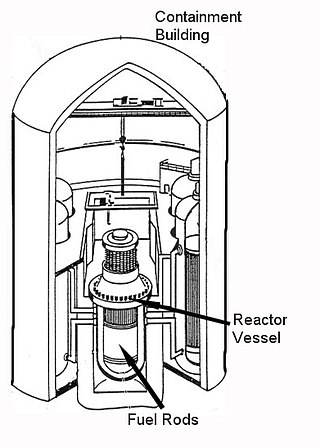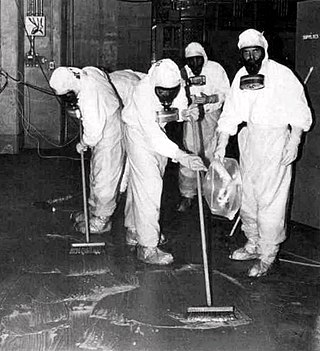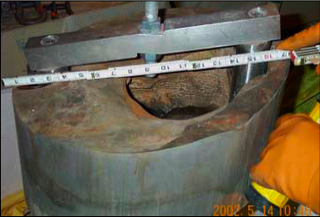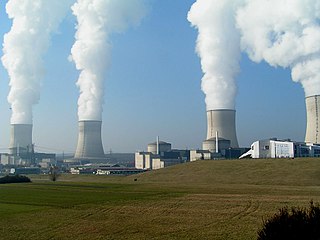Related Research Articles

A nuclear meltdown is a severe nuclear reactor accident that results in core damage from overheating. The term nuclear meltdown is not officially defined by the International Atomic Energy Agency or by the United States Nuclear Regulatory Commission. It has been defined to mean the accidental melting of the core of a nuclear reactor, however, and is in common usage a reference to the core's either complete or partial collapse.

The Nuclear Regulatory Commission (NRC) is an independent agency of the United States government tasked with protecting public health and safety related to nuclear energy. Established by the Energy Reorganization Act of 1974, the NRC began operations on January 19, 1975, as one of two successor agencies to the United States Atomic Energy Commission. Its functions include overseeing reactor safety and security, administering reactor licensing and renewal, licensing radioactive materials, radionuclide safety, and managing the storage, security, recycling, and disposal of spent fuel.

A scram or SCRAM is an emergency shutdown of a nuclear reactor effected by immediately terminating the fission reaction. It is also the name that is given to the manually operated kill switch that initiates the shutdown. In commercial reactor operations, this type of shutdown is often referred to as a "scram" at boiling water reactors (BWR), a "reactor trip" at pressurized water reactors and at a CANDU reactor. In many cases, a scram is part of the routine shutdown procedure, which serves to test the emergency shutdown system.

The Browns Ferry Nuclear Plant is located on the Tennessee River near Decatur and Athens, Alabama, on the north side of Wheeler Lake. The site has three General Electric boiling water reactor (BWR) nuclear generating units and is owned entirely by the Tennessee Valley Authority (TVA). With a generating capacity of nearly 3.8 gigawatts, it is the second most powerful nuclear plant in the United States, behind the Palo Verde Nuclear Generating Station in Arizona, and the most powerful generating station operated by TVA.

The Millstone Nuclear Power Station is the only nuclear power plant in Connecticut and the only multi-unit nuclear plant in New England. It is located at a former quarry in Waterford. With a total capacity of over 2 GW, the station produces enough electricity to power about 2 million homes. The operation of the Millstone Power Station supports more than 3,900 jobs, and generates the equivalent of over half the electricity consumed in Connecticut.

Turkey Point Nuclear Generating Station is a nuclear and gas-fired power plant located on a 3,300-acre (1,300 ha) site two miles east of Homestead, Florida, United States, next to Biscayne National Park located about 25 miles (40 km) south of Miami, Florida near the southernmost edge of Miami-Dade County. The facility is owned by Florida Power & Light.

The Byron Nuclear Generating Station is a nuclear power plant located in Ogle County, Illinois, 2 miles (3.2 km) east of the Rock River. The reactor buildings were constructed by Commonwealth Edison and house two Westinghouse Four-Loop pressurized water reactors, Unit 1 and Unit 2, which began operation in September 1985 and August 1987 respectively. The plant is owned and operated by Constellation Energy.

The Seabrook Nuclear Power Plant, more commonly known as Seabrook Station, is a nuclear power plant located in Seabrook, New Hampshire, United States, approximately 40 miles (64 km) north of Boston and 10 miles (16 km) south of Portsmouth. It has operated since 1990. With its 1,244-megawatt electrical output, Seabrook Unit 1 is the largest individual electrical generating unit on the New England power grid. It is the second largest nuclear plant in New England after the two-unit Millstone Nuclear Power Plant in Connecticut.

Donald C. Cook Nuclear Plant is a nuclear power plant located just north of the city of Bridgman, Michigan which is part of Berrien County, on a 650-acre (260 ha) site 11 miles south of St. Joseph, Michigan, United States. The plant is owned by American Electric Power (AEP) and operated by Indiana Michigan Power, an AEP subsidiary. It has two nuclear reactors and is currently the company's only nuclear power plant.

A containment building is a reinforced steel, concrete or lead structure enclosing a nuclear reactor. It is designed, in any emergency, to contain the escape of radioactive steam or gas to a maximum pressure in the range of 275 to 550 kPa. The containment is the fourth and final barrier to radioactive release, the first being the fuel ceramic itself, the second being the metal fuel cladding tubes, the third being the reactor vessel and coolant system.

The advanced boiling water reactor (ABWR) is a Generation III boiling water reactor. The ABWR is currently offered by GE Hitachi Nuclear Energy (GEH) and Toshiba. The ABWR generates electrical power by using steam to power a turbine connected to a generator; the steam is boiled from water using heat generated by fission reactions within nuclear fuel. Kashiwazaki-Kariwa unit 6 is considered the first Generation III reactor in the world.

The Rancho Seco Nuclear Generating Station is a decommissioned nuclear power plant built by the Sacramento Municipal Utility District (SMUD) in Herald, California.

Nuclear safety is defined by the International Atomic Energy Agency (IAEA) as "The achievement of proper operating conditions, prevention of accidents or mitigation of accident consequences, resulting in protection of workers, the public and the environment from undue radiation hazards". The IAEA defines nuclear security as "The prevention and detection of and response to, theft, sabotage, unauthorized access, illegal transfer or other malicious acts involving nuclear materials, other radioactive substances or their associated facilities".

Nuclear safety in the United States is governed by federal regulations issued by the Nuclear Regulatory Commission (NRC). The NRC regulates all nuclear plants and materials in the United States except for nuclear plants and materials controlled by the U.S. government, as well those powering naval vessels.
George Galatis is a senior nuclear engineer and whistleblower who reported safety problems at the Millstone 1 Nuclear Power Plant, relating to reactor refueling procedures, in 1996. The unsafe procedures meant that spent fuel rod pools at Unit 1 had the potential to boil, possibly releasing radioactive steam throughout the plant. Galatis was the subject of a Time magazine cover story on March 4, 1996. Millstone 1 was permanently closed in July 1998.
The three primary objectives of nuclear reactor safety systems as defined by the U.S. Nuclear Regulatory Commission are to shut down the reactor, maintain it in a shutdown condition and prevent the release of radioactive material.

The United States Government Accountability Office reported more than 150 incidents from 2001 to 2006 of nuclear plants not performing within acceptable safety guidelines. According to a 2010 survey of energy accidents, there have been at least 56 accidents at nuclear reactors in the United States. The most serious of these was the Three Mile Island accident in 1979. Davis-Besse Nuclear Power Plant has been the source of two of the top five most dangerous nuclear incidents in the United States since 1979. Relatively few accidents have involved fatalities.
Boiling water reactor safety systems are nuclear safety systems constructed within boiling water reactors in order to prevent or mitigate environmental and health hazards in the event of accident or natural disaster.
A defence in depth uses multi-layered protections, similar to redundant protections, to create a reliable system despite any one layer's unreliability.

Nuclear power plants pose high risk if chemicals are exposed to those in surrounding communities and areas. This nuclear emergency level classificationresponse system was firstly developed by the US Nuclear Regulatory Commission to allow effective and urgent responses to ultimately control and minimise any detrimental effects that nuclear chemicals can have. These classifications come in four different categories – Unusual Event, Alert, Site Area Emergency (SAE), as well as General Emergency. Thus, each classification has differing characteristics and purposes, depending on the situation at hand. Every nuclear power plant has a different emergency response action plan, also depending on its structure, location and nature. They were developed by thorough discussion and planning with numerous authoritative parties such as local, state, federal agencies as well as other private and non-profit groups that are in association with emergency services. Today, nuclear emergency plans are continuously being developed over time to be improved for future serious events to keep communities and nuclear power plant working members safe. There is a high emphasis for the need of these emergency responses in case of future events. Thus, nuclear plants can, and have paid up to approximately $78 million to ensure that are required measurements are readily available, and that equipment is sufficient and safe. This is applicable for all nuclear power plants in the United States of America.
References
- ↑ "NRC: Glossary - Defense-in-depth". Nrc.gov. 2012-12-26. Retrieved 2013-11-11.
- ↑ Daniel E Whitney (2003). "Normal Accidents by Charles Perrow" (PDF). Massachusetts Institute of Technology.
- ↑ "NRC: 10 CFR Appendix R to Part 50—Fire Protection Program for Nuclear Power Facilities Operating Prior to January 1, 1979". Nrc.gov. Retrieved 2013-11-11.
- 1 2 "Court Victory on Nukes Creates Transparency on Safety Exemptions at Indian Point". 11 January 2013.
- ↑ "Court Upholds NRC Permits For Entergy Nuclear Plant". Law360. 2011-03-07. Retrieved 2013-11-11.
- ↑ "Regulatory Guide 1.174" (PDF). Pbadupws.nrc.gov. Retrieved 2013-11-11.